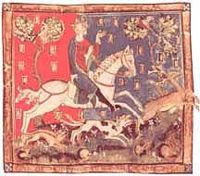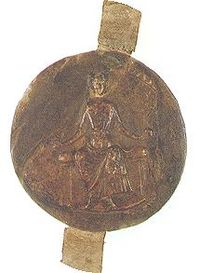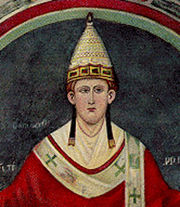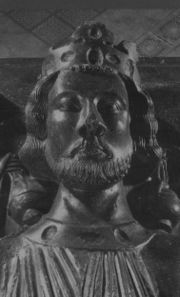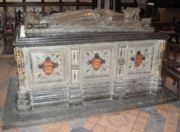John of England
2007 Schools Wikipedia Selection. Related subjects: British History 1500 and before (including Roman Britain); Monarchs of Great Britain
| John | |
|---|---|
| King of England, Lord of Ireland, Duke of Normandy and Aquitaine and Count of Anjou (more...) | |
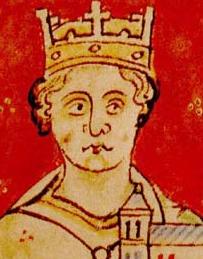 |
|
| John from the Historia Anglorum | |
| Reign | 6 April 1199 – 18/ 19 October 1216 |
| Predecessor | Richard I the Lionheart |
| Successor | Henry III |
| Spouse | Isabella of Angoulême |
| Issue | |
| Henry III Richard, 1st Earl of Cornwall Joan, Queen of Scots Isabella, Holy Roman Empress Eleanor, Countess of Leicester |
|
| Full name | |
| John Plantagenet | |
| Royal house | House of Plantagenet |
| Father | Henry II |
| Mother | Eleanor of Aquitaine |
| Born | 24 December 1166 Beaumont Palace, Oxford |
| Died | 18/ 19 October 1216 Newark-on-Trent, [nottinghamshire] |
| Burial | Worcester Cathedral, Worcester |
John ( 24 December 1166 – 18/ 19 October 1216) reigned as King of England from 6 April 1199, until his death. He succeeded to the throne as the younger brother of King Richard I (known in later times as "Richard the Lionheart"). John acquired the nicknames of "Lackland" (Sans Terre in French) for his lack of an inheritance as the youngest son and for his loss of territory to France, and of "Soft-sword" for his alleged military ineptitude. He was a Plantagenet or Angevin king.
Birth
Born at Beaumont Palace, Oxford, John was the fifth son of King Henry II of England and Eleanor of Aquitaine. He was almost certainly born in 1166 instead of 1167, as is sometimes claimed. King Henry and Queen Eleanor were not together nine months prior to December 1167, but they were together in March 1166. Also, John was born at Oxford on or near Christmas, but Eleanor and Henry spent Christmas 1167 in Normandy. The canon of Laon, writing a century later, states John was named after Saint John the Apostle, on whose feast day ( 27 December) he was born. Ralph of Diceto also states that John was born in 1166, and that Queen Eleanor named him.
He was a younger maternal half-brother of Marie de Champagne and Alix of France. He was a younger brother of William, Count of Poitiers, Henry the Young King, Matilda of England, Richard I of England, Geoffrey II, Duke of Brittany, Leonora of Aquitaine and Joan of England.
Early life
While John was always his father's favourite son, as the youngest he could expect no inheritance. His family life was tumultuous, as his older brothers all became involved in rebellions against Henry. Eleanor was imprisoned by Henry in 1173, when John was a small boy.
Gerald of Wales relates that King Henry had a curious painting in a chamber of Winchester Castle, depicting an eagle being attacked by three of its chicks, while a fourth chick crouched, waiting for its chance to strike. When asked the meaning of this picture, King Henry said:
- The four young ones of the eagle are my four sons, who will not cease persecuting me even unto death. And the youngest, whom I now embrace with such tender affection, will someday afflict me more grievously and perilously than all the others.
Before his accession, John had already acquired a reputation for treachery, having conspired sometimes with and sometimes against his elder brothers, Henry, Richard and Geoffrey. In 1184, John and Richard both claimed that they were the rightful heir to Aquitaine, one of many unfriendly encounters between the two. In 1185, John became the ruler of Ireland, whose people grew to despise him, causing John to leave after only eight months (see: John's first expedition to Ireland).
Richard's absence
During Richard's absence on the Third Crusade from 1190 to 1194, John attempted to overthrow William Longchamp, the Bishop of Ely and Richard's designated justiciar. This was one of the events that inspired later writers to cast John as the villain in their reworking of the legend of Hereward the Wake into Robin Hood, originally set a century before John's time.
While returning from the Crusade, Richard was captured and imprisoned by Henry VI, Holy Roman Emperor. John is said to have sent a letter to Henry asking him to keep Richard away from England for as long as possible, but Richard's supporters paid a ransom for his release because they thought that John would make a terrible king. On his return to England in 1194, Richard forgave John and named him as his heir.
Other historians argue that John did not attempt to overthrow Richard, but rather did his best to improve a country ruined by Richard's excessive taxes used to fund the Crusade. It is most likely that the image of subversion was given to John by later monk chroniclers, who resented his refusal to go on the ill-fated Fourth Crusade.
Reign
Dispute with Arthur I
When Richard died, John did not gain immediate universal recognition as king. Some regarded his young nephew, Arthur of Brittany, the son of John's late brother Geoffrey, as the rightful heir. Arthur fought his uncle for the throne, with the support of King Philip II of France. The conflict between Arthur and King John had fatal consequences.
The war upset the barons of Poitou enough for them to seek redress from the King of France, who was King John's feudal overlord with respect to certain territories on the Continent. In 1202, John was summoned to the French court to answer the charges. John refused and, under feudal law, because of his failure of service to his lord, the French King claimed the lands and territories ruled by King John as Count of Poitou, declaring all John's French territories except Gascony in the southwest forfeit. The French promptly invaded Normandy; King Philip II invested Arthur with all those fiefs King John once held (except for Normandy), and betrothed him to his daughter Mary.
Needing to supply a war across the Channel, in 1203 John ordered all shipyards (including inland places such as Gloucester) in England to provide at least one ship, with places such as the newly-built Portsmouth being responsible for several. He made Portsmouth the new home of the navy (the Anglo-Saxon kings, such as Edward the Confessor, had royal harbours at Sandwich, Kent). By the end of 1204, he had 45 large galleys available to him, and from then on an average of four new ones every year. He also created an Admiralty of four admirals, responsible for various parts of the new navy. During John's reign, major improvements were made in ship design, including the addition of sails and removable forecastles. He also created the first big transport ships, called buisses. John is sometimes credited with the founding of the modern Royal Navy. What is known about this navy comes from the Pipe Rolls, as these achievements are completely ignored by the chroniclers and early historians.
In the hope of avoiding trouble in England and Wales while he was away fighting to recover his French lands, in 1205, John formed an alliance by marrying off his illegitimate daughter, Joan, to the Welsh prince Llywelyn the Great.
As part of the war, Arthur attempted to kidnap his own grandmother, Eleanor of Aquitaine, at Mirebeau, but was defeated and captured by John's forces. Arthur was imprisoned first at Falaise and then at Rouen. No one is certain what happened to Arthur after that. According to the Margam Annals, on 3 April 1203:
- After King John had captured Arthur and kept him alive in prison for some time in the castle of Rouen... when [John] was drunk and possessed by the devil he slew [Arthur] with his own hand and tying a heavy stone to the body cast it into the Seine.
However, Hubert de Burgh, the officer commanding the Rouen fortress, claimed to have delivered Arthur around Easter 1203 to agents of the King sent to castrate him and that Arthur had died of shock. Hubert later retracted his statement and claimed Arthur still lived, but no one ever saw Arthur alive again and the supposition that he was murdered caused Brittany, and later Normandy, to rebel against King John.
Besides Arthur, John also captured his niece, Eleanor, Fair Maid of Brittany. Eleanor remained a prisoner the rest of her life (which ended in 1241); through deeds such as these, John acquired a reputation for ruthlessness.
Dealings with Bordeaux
In 1203, John exempted the citizens and merchants of Bordeaux from the Grande Coutume which was the principal tax on their exports. In exchange, the regions of Bordeaux, Bayonne and Dax pledged support against the French Crown. The unblocked ports gave Gascon merchants open access to the English wine market for the first time. The following year, John granted the same exemptions to La Rochelle and Poitou.
Dispute with the Pope
When Hubert Walter, the Archbishop of Canterbury died on 13 July 1205, John became involved in a dispute with Pope Innocent III. The monks of Christ Church chapter in Canterbury claimed the sole right to elect Hubert's successor, but both the English bishops and the King had an interest in the choice of successor to this powerful office. When their dispute could not be settled, the monks secretly elected one of their members as Archbishop. A second election imposed by John resulted in another nominee. When they both appeared in Rome, Innocent disavowed both elections and his candidate, Stephen Langton, was elected over the objections of John's observers. Innocent thus disregarded the King's rights in selection of his own vassals. John was supported in his position by the English barons and many of the English bishops and refused to accept Langton.
John expelled the Canterbury monks in July 1207 and the Pope ordered an interdict against the kingdom. John immediately retaliated by seizure of church property for failure to provide feudal service, and the fight was on. The pious of England were theoretically left without the comforts of the church, but over a period they became used to this deprivation. The pope, meanwhile, realized that too long a period without church services could lead to loss of faith, and gave permission for some churches to hold Mass behind closed doors in 1209. In 1212, they allowed last rites to the dying. While the interdict was a burden to many, it did not result in rebellion against John.
In November 1209 John himself was excommunicated, and, in February 1213, Innocent threatened stronger measures unless John submitted. The papal terms for submission were accepted in the presence of the papal legate Pandulph in May 1213 (according to Matthew Paris, at the Templar Church at Dover); in addition, John offered to surrender the Kingdom of England to God and the Saints Peter and Paul for a feudal service of 1000 marks annually, 700 for England and 300 for Ireland. With this submission, formalised in the Bulla Aurea (Golden Bull), John gained the valuable support of his papal overlord in his new dispute with the English barons.
Dispute with the barons

Having successfully put down the Welsh Uprising of 1211 and settling his dispute with the papacy, John turned his attentions back to his overseas interests. The European wars culminated in defeat at the Battle of Bouvines, which forced the king to accept an unfavourable peace with France.
This finally turned the barons against him (some had already rebelled against him after he was excommunicated), and he met their leaders at Runnymede, near London, on 15 June 1215, to seal the Great Charter called, in Latin, Magna Carta. Because he had signed under duress, however, John received approval from his overlord the Pope to break his word as soon as hostilities had ceased, provoking the First Barons' War and an invited French invasion by Prince Louis of France (whom the majority of the English barons had invited to replace John on the throne). John travelled around the country to oppose the rebel forces, including a personal two month siege of the rebel-held Rochester Castle.
Death
Retreating from the French invasion, John took a safe route around the marshy area of the Wash to avoid the rebel held area of East Anglia. His slow baggage train (including the Crown Jewels), however, took a direct route across it and were lost on it to the unexpected incoming tide. This dealt John a terrible blow, which affected his health and state of mind. Succumbing to dysentery and moving from place to place, he stayed one night at Sleaford Castle before dying on 18– 19 October 1216, at Newark Castle (then in Lincolnshire, now on Nottinghamshire's border with that county). Numerous, if fictitious, accounts circulated soon after his death that he had been killed by poisoned ale, poisoned plums or a "surfeit of peaches".
He was buried in Worcester Cathedral in the city of Worcester.
Succession
His nine-year-old son succeeded him and became King Henry III of England (1216–72), and although Louis continued to claim the English throne, the barons switched their allegiance to the new king, forcing Louis to give up his claim and sign the Treaty of Lambeth in 1217.
Reputation and overview
King John's reign has been traditionally characterised as one of the most disastrous in English history: it began with defeats—he lost Normandy to Philip Augustus of France in his first five years on the throne—and ended with England torn by civil war and himself on the verge of being forced out of power. In 1213, he made England a papal fief to resolve a conflict with the Roman Catholic Church, and his rebellious barons forced him to sign Magna Carta in 1215, the act for which he is best remembered. Some have argued, however, that John's rule was no better or worse than those of kings Richard I or Henry III, adding that (unlike Richard) he spent the majority of his reign in England. Be that as it may, his reputation is a reason many English monarchs have refrained from giving the name John to their expected heirs.
As far as the administration of his kingdom went, John functioned as an efficient ruler, but he won the disapproval of the English barons by taxing them in ways that were outside those traditionally allowed by feudal overlords. The tax known as scutage, payment made instead of providing knights (as required by feudal law), became particularly unpopular. John was a very fair-minded and well informed king, however, often acting as a Judge in the Royal Courts, and his justice was much sought after. Also, John's employment of an extremely able Chancellor and certain clerks resulted in the first proper set of records - the Pipe Rolls.
Medieval historian C. Warren Hollister called John an "enigmatic figure":
...talented in some respects, good at administrative detail, but suspicious, unscrupulous, and mistrusted. He was compared in a recent scholarly article, perhaps unfairly, with Richard Nixon. His crisis-prone career was sabotaged repeatedly by the halfheartedness with which his vassals supported him—and the energy with which some of them opposed him.
Depictions in fiction
These reflect the overwhelming view of his reputation:
- King John was the subject of a Shakespearean play, King John.
- King John is a central figure in the 1819 historical romance Ivanhoe, by Sir Walter Scott.
- Philip José Farmer, a science fiction author, featured King John as one of several historical figures in his Riverworld Saga.
- John and one of his Justices in Eyre, the Sheriff of Nottingham, are portrayed as the villain and henchman in the Robin Hood legends. These usually place the Robin Hood stories in the latter part of Richard I's reign, when Richard was in captivity and John was acting as unofficial regent. Among the screen incarnations of John in versions of the Robin Hood story are:
- Sam De Grasse in Robin Hood (1922).
- Claude Rains in The Adventures of Robin Hood (1938).
- Donald Pleasence in the 1950s ITV television series The Adventures of Robin Hood.
- the animated Prince John in the 1973 Disney movie Robin Hood, in which he is depicted as an anthropomorphic lion voiced by Peter Ustinov, who sucks his thumb and cries for his "mommy" whenever Robin Hood (a fox) steals his gold. In one scene, he laments, "Mommy always did like Richard best".
- Phil Davis in the 1980s television series Robin of Sherwood.
- Richard Lewis in Robin Hood: Men in Tights (1993).
- John was impersonated by Kamelion in a plot by the Master in The King's Demons, a 1983 serial of the British science fiction series, Doctor Who.
- John is a character in James Goldman's 1966 play The Lion in Winter, which dramatises Henry II's struggles with his wife and sons over the rule of his empire. John is portrayed as a spoiled, simpleminded pawn in the machinations of his brothers and Philip II. In the 1968 film he is portrayed by Nigel Terry. In the 2003 film he is portrayed by Rafe Spall.
- Sharon Penman's Here Be Dragons deals with the reign of John, the development of Wales under Llewelyn's rule, and Llewelyn's marriage to John's illegitimate daughter, Joan, who is depicted in the novel as "Joanna." Other novels of hers which feature John as a prominent character are The Queen's Man, Cruel as the Grave, The Dragon's Lair, and Prince of Darkness, a series of fictional mysteries set during the time of Richard's imprisonment.
- The Devil and King John by Philip Lindsay is a highly speculative but relatively sympathetic account.
- King John appeared in The Time Tunnel episode entitled "The Revenge of Robin Hood". Once again, John is depicted as a villain. At the end of the episode, John puts his seal on the Magna Carta but clearly he is not happy about it. He is portrayed by character actor John Crawford.
- King John is the subject of A. A. Milne's poem for children which begins "King John was not a good man".
- " Princess Of Thieves," a story about Robin Hood's daughter, Prince John tries to seize the throne away from the rightful heir, Prince Phillip, an illegitemate son of king Richard
Marriage and issue
In 1189, John was married to Isabel of Gloucester, daughter and heiress of William Fitz Robert, 2nd Earl of Gloucester (she is given several alternative names by history, including Avisa, Hawise, Joan, and Eleanor). They had no children, and John had their marriage annulled on the grounds of consanguinity, some time before or shortly after his accession to the throne, which took place on 6 April 1199, and she was never acknowledged as queen. (She then married Geoffrey de Mandeville as her second husband and Hubert de Burgh as her third).
John remarried, on 24 August 1200, Isabella of Angoulême, who was twenty years his junior. She was the daughter of Aymer Taillefer, Count of Angouleme. John had kidnapped her from her fiancé, Hugh X of Lusignan. Isabelle eventually produced five children, including two sons (Henry and Richard), and three daughters ( Joan, Isabella and Eleanor).
John is given a great taste for lechery by the chroniclers of his age, and even allowing some embellishment, he did have many illegitimate children. Matthew Paris accuses him of being envious of many of his barons and kinsfolk, and seducing their more attractive daughters and sisters. Roger of Wendover describes an incident that occurred when John became enamoured of Margaret, the wife of Eustace de Vesci and an illegitimate daughter of King William I of Scotland. Eustace substituted a prostitute in her place when the king came to Margaret's bed in the dark of night; the next morning, when John boasted to Vesci of how good his wife was in bed, Vesci confessed and fled.
John had the following illegitimate children:
- Joan, the wife of Llywelyn Fawr, (by a woman named Clemence)
- Richard Fitz Roy, (by his cousin, Adela, daughter of his uncle Hamelin de Warenne)
- Oliver FitzRoy, (by mistress named Hawise)who accompanied the papal legate Pelayo to Damietta in 1218, and never returned.
By an unknown mistress (or mistresses) John fathered:
- Geoffrey FitzRoy, who went on expedition to Poitou in 1205 and died there.
- John FitzRoy, a clerk in 1201.
- Henry FitzRoy, who died in 1245.
- Osbert Gifford, who was given lands in Oxfordshire, Norfolk, Suffolk, and Sussex, and is last seen alive in 1216.
- Eudes FitzRoy, who accompanied his half-brother Richard on Crusade and died in the Holy Land in 1241.
- Bartholomew FitzRoy, a member of the order of Friars Preachers.
- Maud FitzRoy, Abbess of Barking, who died in 1252.
- Isabel FitzRoy, wife of Richard Fitz Ives.
- Philip FitzRoy, found living in 1263.
(The surname of FitzRoy is Norman-French for son of the king.)
Trivia
- According to records of payment made to King John's bath attendant, William Aquarius, the king bathed on average about once every three weeks, which cost a considerable sum of 5d to 6d each, suggesting an elaborate and ceremonial affair. Although this may seem barbaric by modern standards, it was civilised compared to monks who were expected to bathe three times a year, with the right not to bathe at all if they so chose.
- John is recorded to have dressed very well in coats made of fur from sable and ermine and other exotic furs such as polar bear.
- In 2006, he was selected by the BBC History Magazine as the 13th century's worst Briton.
Alleged illiteracy
For a long time, schoolchildren have been told that King John had to approve Magna Carta by attaching his seal to it because he could not sign it, lacking the ability to read or write. This textbook inaccuracy ignored the fact that King John had a large library he treasured until the end of his life. Whether the original authors of these errors knew better and oversimplified because they wrote for children, or whether they had been misinformed themselves, is unknown. As a result of these writings, generations of adults remembered mainly two things about "wicked King John," both of them wrong. (The other "fact" was that, if Robin Hood had not stepped in, Prince John would have embezzled the money raised to ransom King Richard. The fact is that John did embezzle the ransom money, by creating forged seals. Robin Hood, on the other hand, may or may not have actually existed.)
King John did actually sign the draft of the Charter that the negotiating parties hammered out in the tent on Charter Island at Runnymede on 15– 18 June 1215, but it took the clerks and scribes working in the royal offices some time after everyone went home to prepare the final copies, which they then sealed and delivered to the appropriate officials. In those days, legal documents were made official by seals, not by signatures. (Even today, many legal documents are not considered effective without the seal of a notary public or corporate official, and printed legal forms such as deeds say "L.S." next to the signature lines. That stands for the Latin locus sigilli ("place of the seal"), signifying that the signer has used a signature as a substitute for a seal.) When William the Conqueror (and his wife) signed the Accord of Winchester (Image) in 1072, for example, they and all the bishops signed with crosses, as illiterate people would later do, but they did so in accordance with current legal practice, not because the bishops could not write their own names.
Henry II had at first intended that John would receive an education to go into the Church, which would have meant Henry did not have to give him any land. In 1171, however, Henry began negotiations to betroth John to the daughter of Count Humbert III of Savoy (who had no son yet and so wanted a son-in-law.) After that, talk of making John a cleric ceased. John's parents had both received a good education — Henry spoke some half dozen languages, and Eleanor had attended lectures at what would soon become the University of Paris — in addition to what they had learned of law and government, religion, and literature. John himself had received one of the best educations of any king of England. Some of the books the records show he read included: De Sacramentis Christianae Fidei by Hugh of St. Victor, Sentences by Peter Lombard, The Treatise of Origen, and a history of England—potentially Wace's Roman de Brut, based on Geoffrey of Monmouth's Historia Regum Britanniae.
